简单句的七种类型
- 格式:ppt
- 大小:672.50 KB
- 文档页数:40
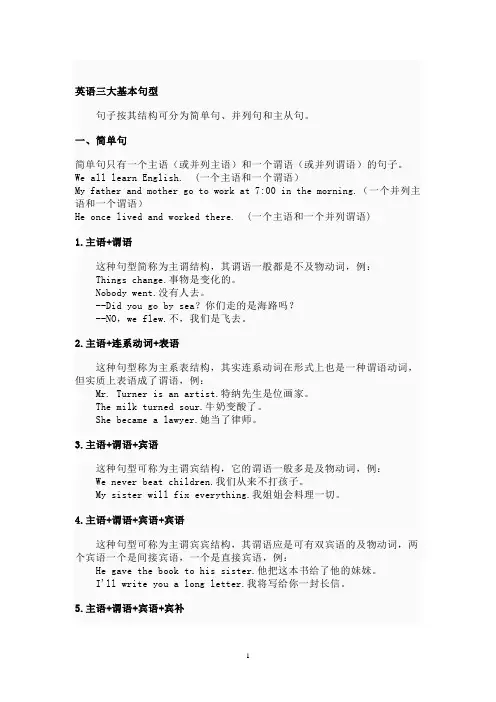
英语三大基本句型句子按其结构可分为简单句、并列句和主从句。
一、简单句简单句只有一个主语(或并列主语)和一个谓语(或并列谓语)的句子。
We all learn English. (一个主语和一个谓语)My father and mother go to work at 7:00 in the morning.(一个并列主语和一个谓语)He once lived and worked there. (一个主语和一个并列谓语)1.主语+谓语这种句型简称为主谓结构,其谓语一般都是不及物动词,例:Things change.事物是变化的。
Nobody went.没有人去。
--Did you go by sea?你们走的是海路吗?--NO,we flew.不,我们是飞去。
2.主语+连系动词+表语这种句型称为主系表结构,其实连系动词在形式上也是一种谓语动词,但实质上表语成了谓语,例:Mr. Turner is an artist.特纳先生是位画家。
The milk turned sour.牛奶变酸了。
She became a lawyer.她当了律师。
3.主语+谓语+宾语这种句型可称为主谓宾结构,它的谓语一般多是及物动词,例:We never beat children.我们从来不打孩子。
My sister will fix everything.我姐姐会料理一切。
4.主语+谓语+宾语+宾语这种句型可称为主谓宾宾结构,其谓语应是可有双宾语的及物动词,两个宾语一个是间接宾语,一个是直接宾语,例:He gave the book to his sister.他把这本书给了他的妹妹。
I'll write you a long letter.我将写给你一封长信。
5.主语+谓语+宾语+宾补这种句型可简称为主谓宾补结构,其补语是宾语补语,与宾语一起即构成复合宾语,例:I found the book easy.我发现这本书不难。
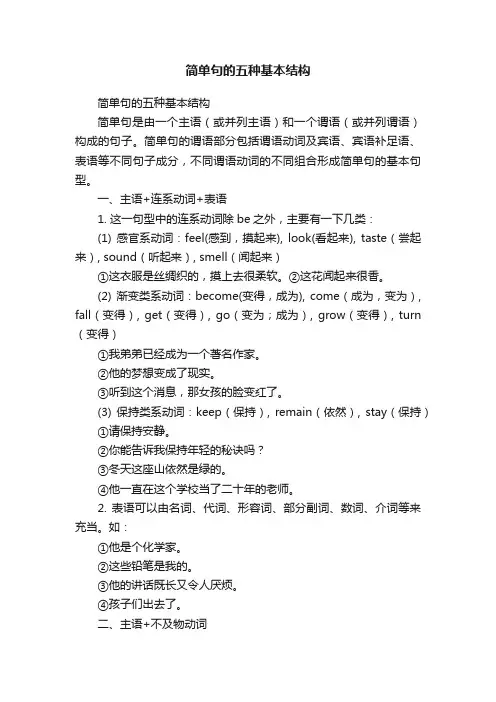
简单句的五种基本结构简单句的五种基本结构简单句是由一个主语(或并列主语)和一个谓语(或并列谓语)构成的句子。
简单句的谓语部分包括谓语动词及宾语、宾语补足语、表语等不同句子成分,不同谓语动词的不同组合形成简单句的基本句型。
一、主语+连系动词+表语1. 这一句型中的连系动词除be之外,主要有一下几类:(1) 感官系动词:feel(感到,摸起来), look(看起来), taste(尝起来), sound(听起来), smell(闻起来)①这衣服是丝绸织的,摸上去很柔软。
②这花闻起来很香。
(2) 渐变类系动词:become(变得,成为), come(成为,变为), fall(变得), get(变得), go(变为;成为), grow(变得), turn (变得)①我弟弟已经成为一个著名作家。
②他的梦想变成了现实。
③听到这个消息,那女孩的脸变红了。
(3) 保持类系动词:keep(保持), remain(依然), stay(保持)①请保持安静。
②你能告诉我保持年轻的秘诀吗?③冬天这座山依然是绿的。
④他一直在这个学校当了二十年的老师。
2. 表语可以由名词、代词、形容词、部分副词、数词、介词等来充当。
如:①他是个化学家。
②这些铅笔是我的。
③他的讲话既长又令人厌烦。
④孩子们出去了。
二、主语+不及物动词1. 本句型的不及物动词是表意动词,在句中作谓语,说明主语的行动、状态或心理活动。
有时态变化,人称和数要和主语保持一致。
常见的不及物动词有agree, arrive, burn, come, dance, die, fall, fly, go, hurry, jump, leave(离开), listen, live, look, move, play, rest, ring, rise, run, shout, sit, skate, smile, snow, speak, stand, stay, stop, swim, travel, talk, try, wait, walk, work, worry等(1) 月亮升起来了。

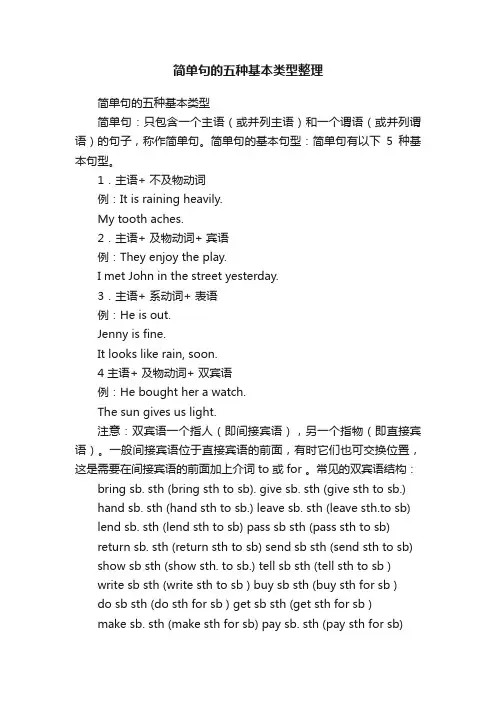
简单句的五种基本类型整理简单句的五种基本类型简单句:只包含一个主语(或并列主语)和一个谓语(或并列谓语)的句子,称作简单句。
简单句的基本句型:简单句有以下5种基本句型。
1.主语+ 不及物动词例:It is raining heavily.My tooth aches.2.主语+ 及物动词+ 宾语例:They enjoy the play.I met John in the street yesterday.3.主语+ 系动词+ 表语例:He is out.Jenny is fine.It looks like rain, soon.4 主语+ 及物动词+ 双宾语例:He bought her a watch.The sun gives us light.注意:双宾语一个指人(即间接宾语),另一个指物(即直接宾语)。
一般间接宾语位于直接宾语的前面,有时它们也可交换位置,这是需要在间接宾语的前面加上介词to 或for 。
常见的双宾语结构:bring sb. sth (bring sth to sb). give sb. sth (give sth to sb.) hand sb. sth (hand sth to sb.) leave sb. sth (leave sth.to sb) lend sb. sth (lend sth to sb) pass sb sth (pass sth to sb)return sb. sth (return sth to sb) send sb sth (send sth to sb) show sb sth (show sth. to sb.) tell sb sth (tell sth to sb )write sb sth (write sth to sb ) buy sb sth (buy sth for sb )do sb sth (do sth for sb ) get sb sth (get sth for sb )make sb. sth (make sth for sb) pay sb. sth (pay sth for sb)sing sb sth (sing sth for sb )5.主语+ 及物动词+ 宾语+ 补足语例:She found him a very clever student.I make it a rule to get up early in the morning.注意:当宾语意思表达不完整时,需要用不足与补充说明宾语的状态、性质等。

十、简单句1、简单句的特点:简单句通常只由一个主语(或并列主语)和一个谓语(或并列谓语)构成。
2、简单句的种类:简单句一般分为陈述句、疑问句、感叹句和祈使句四种。
3、陈述句:用来说明一个事实的句子叫陈述句。
它有肯定式和否定式两种形式。
▲陈述句的肯定式: He is a middle school student.(他是个中学生)/ I have a hammer in my hand.(我手上有把锤子)/ She teaches us geography.(她教我们地理)/ The new play was good enough and everybody enjoyed it.(新的话剧非常好大家都喜欢)▲陈述句的否定式:1)谓语动词如果是 be 、助动词、情态动词时,在它们的后面加“not‖。
如:My brother is not a teacher.(我的弟弟不是教师)/ He does not have a cousin.(他没有堂兄弟)/ I will not go there tomorrow.(明天我不去那儿)/ My mother is not cooking a meal in the kitchen.(我母亲现在不在厨房里做饭)/ You must not make such mistakes again.(你不该再犯类似错误了) / We haven’t discussed the question yet(我们还没有讨论那个问题呢).2)谓语动词如果没有上述词语而是其他动词时,须在它的前面加do not(don’t).如: I don’t know anything about it.(此事我一无所知) / Li Ming does not feed pigs in the countryside.(李明不在农村养猪)/ We didn’t expect to meet her right here.(我们没指望着在这里见到她)/ We didn’t have a meeting yesterday afternoon.(昨天下午我们没有开会)3)如果“have‖作―有‖讲,也可以在它后面加not构成否定式,其形式与have got的否定式相同。
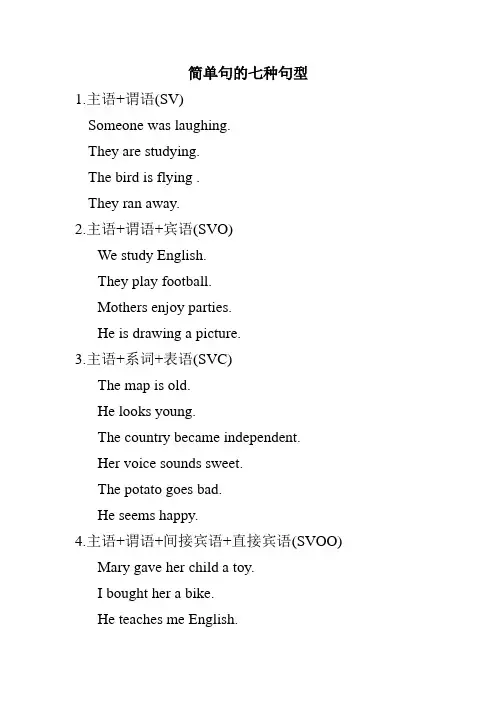
简单句的七种句型1.主语+谓语(SV)Someone was laughing.They are studying.The bird is flying .They ran away.2.主语+谓语+宾语(SVO)We study English.They play football.Mothers enjoy parties.He is drawing a picture.3.主语+系词+表语(SVC)The map is old.He looks young.The country became independent.Her voice sounds sweet.The potato goes bad.He seems happy.4.主语+谓语+间接宾语+直接宾语(SVOO)Mary gave her child a toy.I bought her a bike.He teaches me English.The teacher lent me two books.5.主语+谓语+宾语+宾语补足语(SVOC)We consider these books expensive.They call him little Tom.I will tell her to wait for you.They ordered us to go away.6.主语+谓语+状语(SV A)He lives in New York.He is working in the field.He gets up at seven in the morning.She is laughing in her room.7. 主语+谓语+宾语+状语(SVOA)You must return these books to the library.We will call on you in your office.We saw a film at the cinema last night.They are studying English in the classroom now.I met an old friend of mine in the street this morning.。
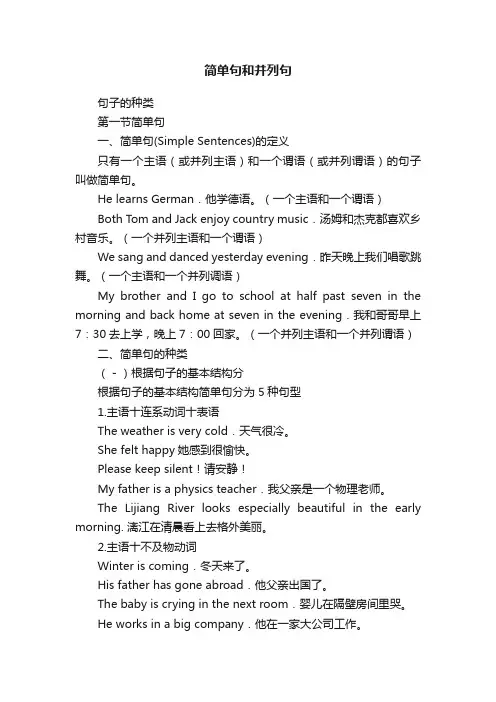
简单句和并列句句子的种类第一节简单句一、简单句(Simple Sentences)的定义只有一个主语(或并列主语)和一个谓语(或并列谓语)的句子叫做简单句。
He learns German.他学德语。
(一个主语和一个谓语)Both Tom and Jack enjoy country music.汤姆和杰克都喜欢乡村音乐。
(一个并列主语和一个谓语)We sang and danced yesterday evening.昨天晚上我们唱歌跳舞。
(一个主语和一个并列调语)My brother and I go to school at half past seven in the morning and back home at seven in the evening.我和哥哥早上7:30去上学,晚上7:00回家。
(一个并列主语和一个并列谓语)二、简单句的种类(-)根据句子的基本结构分根据句子的基本结构简单句分为5种句型1.主语十连系动词十表语The weather is very cold.天气很冷。
She felt happy她感到很愉快。
Please keep silent!请安静!My father is a physics teacher.我父亲是一个物理老师。
The Lijiang River looks especially beautiful in the early morning. 漓江在清晨看上去格外美丽。
2.主语十不及物动词Winter is coming.冬天来了。
His father has gone abroad.他父亲出国了。
The baby is crying in the next room.婴儿在隔壁房间里哭。
He works in a big company.他在一家大公司工作。
We have lived in the city for ten years.我们在这座城市已生活了10年。
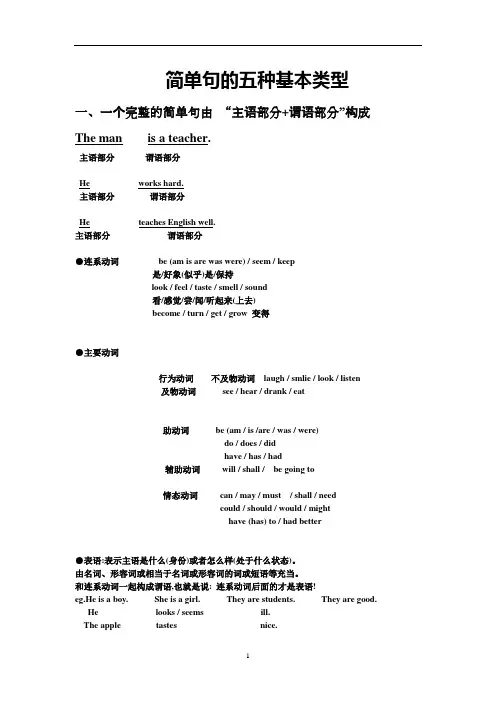
简单句的五种基本类型一、一个完整的简单句由“主语部分+谓语部分”构成The man is a teacher.主语部分谓语部分He works hard.主语部分谓语部分He teaches English well.主语部分谓语部分●连系动词be (am is are was were) / seem / keep是/好象(似乎)是/保持look / feel / taste / smell / sound看/感觉/尝/闻/听起来(上去)become / turn / get / grow 变得●主要动词行为动词不及物动词laugh / smlie / look / listen及物动词see / hear / drank / eat助动词be (am / is /are / was / were)do / does / didhave / has / had辅助动词will / shall / be going to情态动词can / may / must / shall / needcould / should / would / mighthave (has) to / had better●表语:表示主语是什么(身份)或者怎么样(处于什么状态)。
由名词、形容词或相当于名词或形容词的词或短语等充当。
和连系动词一起构成谓语,也就是说: 连系动词后面的才是表语!eg.He is a boy. She is a girl. They are students. They are good.He looks / seems ill.The apple tastes nice.Trees turn green.Your idea sounds good.●什么是及物动词和不及物动词呢⑴、及物动词是后面可以直接跟宾语的动词: see / hear / drank / eat / …I saw him last week.We heard the bad news yesterday.They eat bread every day.He drank a glass of milk just now.⑵、不及物动词是后面不可以直接跟宾语的动词: laugh / smile / look / listen / …She smiled happily.They laughed loudly.(3)、如果要加宾语,就要靠一个介词来帮助:She look at the blackboard carefully.He listened to his teacher in class.They laughed at us after the match.及物动词例句:She teaches us.She teaches EnglishShe teaches us EnglishShe told me a storyHe gave me a present二、主谓双宾结构主语+谓语+间接宾语+直接宾语可以用于这种句式的动词主要有(A) buy / build / catch / cut choose / cook / find / get / keep / make / draw / doHe bought me a new bike.也可以改为for sb. 的句式He bought a new bike for me.(B) give / take / send / bring / teach / show / tell / pay / write / read / sell / lend / pass / return / throw / offer / handShe lent me a book.也可以改为to sb. 的句式She lent a book to me.三、主谓宾宾补结构主语+谓语+宾语+宾语的补足语He told me to clean my room.I saw her dancingOur teacher asks us to read English every day.可以用于这种句式的动词主要有let / make sb. do sth.ask / tell / want / allow / wish . sb. to do sth.expect / encourage / invite / teachfind / see / hear / watch / notice / feel ①sb. do sth.②sb. doing sthhelp sb. (to) do sthhope和welcome 比较特殊--我们可以说:I hope to visit your school.I hope that you can visit our school.I wish you to visit our school.Welcome to visit our school.You are welcome to visit our school.Welcome to our school.但不可以说:I hope / welcome you to visit our school原来也蛮简单的哦!我来分析一下这些句子中所包含的成分[1]主系表型She is a very good girl .(主语) (连系动词) (表语)The girl is very good.(主语) (连系动词) (表语)[2] 主谓型①、主谓式: They ‖laughed.(主语) (谓语动词)The kites ‖fly in the sky.(主语) (谓语动词)②主谓宾式: I ‖bought a new bike.(主语) (谓语动词) (宾语)He ‖plays volleyball.(主语) (谓语动词) (宾语)[3]主谓宾宾式:She ‖told me a story.(主语) (谓语动词) (宾语) (宾语He ‖gave me a good book.(主语) (谓语动词) (宾语) (宾语)[4]主谓宾宾补式He ‖asked me to help him.(主语) (谓语动词) (宾语) (宾语补足语)He ‖made me happy. (主语) (谓语动词) (宾语) (宾语补足语)。
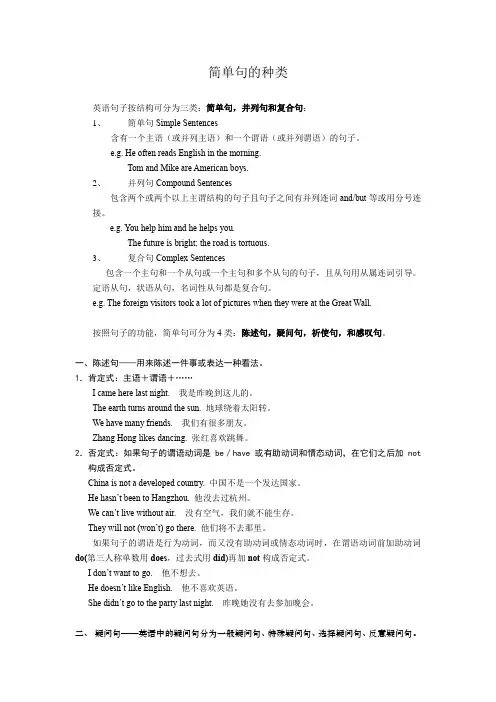
简单句的种类英语句子按结构可分为三类:简单句,并列句和复合句:1、简单句Simple Sentences含有一个主语(或并列主语)和一个谓语(或并列谓语)的句子。
e.g. He often reads English in the morning.Tom and Mike are American boys.2、并列句Compound Sentences包含两个或两个以上主谓结构的句子且句子之间有并列连词and/but等或用分号连接。
e.g. You help him and he helps you.The future is bright; the road is tortuous.3、复合句Complex Sentences包含一个主句和一个从句或一个主句和多个从句的句子,且从句用从属连词引导。
定语从句,状语从句,名词性从句都是复合句。
e.g. The foreign visitors took a lot of pictures when they were at the Great Wall.按照句子的功能,简单句可分为4类:陈述句,疑问句,祈使句,和感叹句。
一、陈述句——用来陈述一件事或表达一种看法。
1.肯定式:主语+谓语+……I came here last night. 我是昨晚到这儿的。
The earth turns around the sun. 地球绕着太阳转。
We have many friends. 我们有很多朋友。
Zhang Hong likes dancing. 张红喜欢跳舞。
2.否定式:如果句子的谓语动词是be/have或有助动词和情态动词,在它们之后加not 构成否定式。
China is not a developed country. 中国不是一个发达国家。
He hasn’t been to Hangzhou. 他没去过杭州。
We can’t live without air. 没有空气,我们就不能生存。
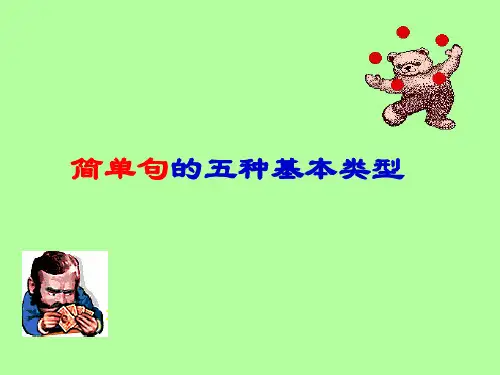
![英语简单句的五种基本类型一览表[1]](https://uimg.taocdn.com/d68b249efbb069dc5022aaea998fcc22bdd14318.webp)
英语简单句的五种基本类型一览表
广义上讲,文章的最小单位是句子.句子才是文章的最基本的组成部分.高考题中的书面表达除了对考生的怎么笔头表达的整体结构有所要求外,更重要的是看考生的语句的使用情况是否正确、是否得当、是否地道。
因此, 只有熟练地掌握了句子的基本类型和常用句型, 考生才能灵活自如的发挥自己的写作才能。
而句子的灵魂是动词, 在句子中, 动词起了不可或缺的作用。
现将句子的基本类型与常用句型分述如下:
(一)句子的基本类型
类型1: 主语+谓语(+状语)
Example1:
Example 2:
Example3:
类型2: 主语+谓语+宾语Example1:
Example2:
Example 3:
Example4:
类型3:主语+谓语+表语Example 1:
Example 2:
类型4: 主语+谓语+间接宾语+直接宾语Example1:
Example2:
Example3:
Example4:
类型5: 主语+谓语+宾语+宾语补足语Example1:
Example2:
Example3:
Example4:
Example5:
Example6:
Example7:。
英语六大简单句的定义、特点和例子英语中,句子的结构可以分为简单句、并列句、复合句和复杂句。
简单句是由一个主语和一个谓语组成的最基本的句子类型,没有从句或并列成分。
简单句可以根据谓语的不同,分为六种类型:主谓结构、主系表结构、主谓宾结构、主谓双宾结构、主谓宾补结构和主谓状结构。
本文将介绍这六种简单句的定义、特点和例子,帮助读者掌握英语简单句的用法和变化。
一、主谓结构主谓结构是最简单的一种简单句,由一个主语和一个不及物动词组成,表示一个动作或状态。
不及物动词是指不能带宾语的动词,如run, sleep, cry等。
主谓结构的基本形式是:主语 + 不及物动词例如:He runs every morning. 他每天早上跑步。
She sleeps well. 她睡得很好。
The baby cried. 婴儿哭了。
主谓结构可以通过添加状语来修饰不及物动词,表示时间、地点、方式、原因等。
状语可以是副词、介词短语或从句等。
例如:He runs fast. 他跑得快。
She sleeps in her room. 她在她的房间睡觉。
The baby cried because he was hungry. 婴儿因为饿了而哭。
二、主系表结构主系表结构是由一个主语、一个系动词和一个表语组成的简单句,表示一个判断或说明。
系动词是指用来连接主语和表语的动词,如be, become, seem等。
表语是指用来说明或补充主语的成分,可以是名词、形容词、副词、介词短语或从句等。
主系表结构的基本形式是:主语 + 系动词 + 表语例如:He is a teacher. 他是一名老师。
She became angry. 她变得生气了。
It seems interesting. 这看起来很有趣。
主系表结构可以通过添加状语来修饰系动词或表语,表示时间、地点、方式、原因等。
例如:He is a teacher in our school. 他是我们学校的一名老师。
英语简单句类型
英语简单句类型包括以下几种:
1. 主语 + 谓语:这是最简单的简单句类型,表示一个主语和一个谓语之间的关系。
例如:I love you.(我爱你。
)
2. 主语 + 谓语 + 宾语:这种简单句类型表示一个主语和一个谓语和一个宾语之间的关系。
例如:She sings well.(她唱歌唱得好。
)
3. 主语 + 谓语 + 宾语 + 宾语补足语:这种简单句类型表示一个主语和一个谓语和一个宾语和一个宾语补足语之间的关系。
宾语补足语是一个额外的词语或短语,用于补充说明宾语的性质或状态。
例如:He drinks coffee every day.(他每天喝咖啡。
)
4. 主语 + 谓语 + 宾语 + 宾语补足语 + 定语:这种简单句类型表示一个主语和一个谓语和一个宾语和一个宾语补足语和一个定语之间的关系。
定语是一个额外的词语或短语,用于描述主语或宾语。
例如:The dog that I saw yesterday is my friend.(那只我昨天看到的狗是我的好友。
)
5. 主语 + 谓语 + 宾语 + 宾语补足语 + 状语:这种简单句类型表示一个主语和一个谓语和一个宾语和一个宾语补足语和一个状语之间的关系。
状语是一个额外的词语或短语,用于描述主语或宾语的状态或行为方式。
例如:I will go to the store that is near my home.(我会去那家离我很近的商店。
)
1/ 1。
简单句的七种基本句型英语句子按照其结构可分为简单句、并列句和复合句。
简单句的基本形式由一个主语(或并列主语)和一个谓语(或并列谓语)构成。
1.主谓(SV)[观察例句]The rain stopped.雨停了。
The moon rose.月亮升起来了。
[归纳用法]句型特点:谓语动词是不及物动词,本身能表达完整的意思,后面不需接宾语。
2.主谓状(SV A)[观察例句]The time passed quickly.时间过得很快。
The old man walks in the park every morning.那个老人每天早上在公园里散步。
[归纳用法]句型特点:谓语动词是不及物动词,副词、介词短语等作状语。
3.主谓宾(SVO)[观察例句]We are learning English.我们正在学习英语。
I don't know how to get there.我不知道怎么去那儿。
[归纳用法]句型特点:谓语动词是及物动词,不能表达完整的意思,其后必须要接一个宾语,即动作的承受者。
作宾语的可以是:名词、代词、动词不定式、疑问词+动词不定式、动词ing形式和从句。
4.主谓宾状(SVOA)[观察例句]I like to stay at home on Sundays.星期天我喜欢待在家里。
We planted many trees in our hometown.我们在家乡种了许多树。
[归纳用法]句型特点:谓语动词是及物动词,其后接宾语。
副词、介词短语等作状语。
5.主谓双宾语(SVIODO)[观察例句]Her mother bought her a skirt.她妈妈给她买了一条裙子。
Mr Li told us an interesting story.李老师给我们讲了一个非常有趣的故事。
[归纳用法]句型特点:谓语动词后接有两个宾语,这两个宾语都是动作的对象或承受者,其中指人的是间接宾语,指物的是直接宾语。
简单句的六种基本句型讲解一、简单句的六种基本句型1.主语+谓语A bad thing happened.We worked in the city.I will go at six.She is crying for getting lost.The man doesn’t smoke.The books sell well.Time goes by.2.主语+谓语+宾语The teacher said “Good evening”.My sister likes apples.I’d like to drink a cup of tea.She likes English most.3.主语+谓语+间接宾语+直接宾语Tom passed his mother the salt at the table.Lily teaches me English.My mother told me a story.The little boy bought his mother a present on Mother’s day.I gave him a hand.4.主语+谓语+宾语+宾语补足语Tom made the baby laugh.They painted the doorred.We saw him go out.He asked me to come back soon.They call him Bob.5.主语+系动词+表语He is a student.Everything looks different.Her face turned red.He felt happy.She should keep healthy.6.There be 句型是英语中常用句型,意思是“有”,表示“人或事物的存在”或“某地有某物”。
There在此结构中是引导词,已经没有副词“那里”的含义。
There is a ruler,two pens and five books in the school bag.There is still another 20 miles to drive.There used to be a castle at the foot of the hill.There lived an old man in the small house.There is no knowing what may happen. =It is impossible to know what may happen.二、句子成份英语句子成分有主语,谓语,宾语,宾语补足语,表语,定语,状语等。